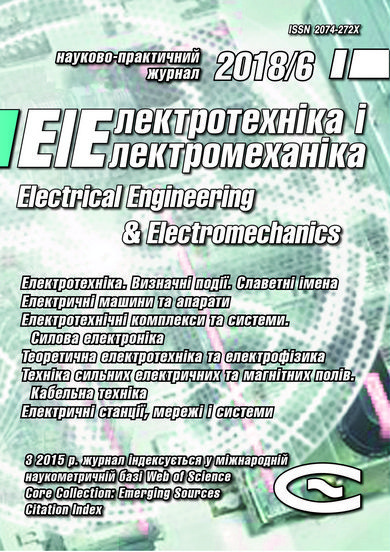IMPROVING OF ELECTROMECHANICAL SERVO SYSTEMS ACCURACY
DOI:
https://doi.org/10.20998/2074-272X.2018.6.04Keywords:
electromechanical servo systems of guidance and stabilization of lightly armored vehicle weapon, nonlinear robust system, multiobjective synthesis, dynamic characteristicsAbstract
Aim. Improving of accuracy parameters and reducing of sensitivity to changes of plant parameters of nonlinear robust electromechanical servo systems of guidance and stabilization of lightly armored vehicle weapons based on multiobjective synthesis. Methodology. The method of multicriterion synthesis of nonlinear robust controllers for controlling by nonlinear multimass electromechanical servo systems with parametric uncertainty based on the choice of the target vector of robust control by solving the corresponding multicriterion nonlinear programming problem in which the calculation of the vectors of the objective function and constraints is algorithmic and associated with synthesis of nonlinear robust controllers and modeling of the synthesized system for various modes of operation of the system, with different input signals and for various values of the plant parameters. Synthesis of nonlinear robust controllers and non-linear robust observers reduces to solving the system of Hamilton-Jacobi-Isaacs equations. Results. The results of the synthesis of a nonlinear robust electromechanical servo system for the guidance and stabilization of lightly armored vehicle weapons are presented. Comparison of the dynamic characteristics of the synthesized servo electromechanical system showed that the use of synthesized nonlinear robust controllers allowed to improve the accuracy parameters and reduce the sensitivity of the system to changes of plant parameters in comparison with the existing system. Originality. For the first time carried out the multiobjective synthesis of nonlinear robust electromechanical servo systems of guidance and stabilization of lightly armored vehicle weapons. Practical value. Practical recommendations are given on reasonable choice of the gain matrix for the nonlinear feedbacks of the regulator and the nonlinear observer of the servo electromechanical system, which allows improving the dynamic characteristics and reducing the sensitivity of the system to plant parameters changing in comparison with the existing system.References
1. Bezvesilna O.M., Kvasnikov V.P., Klymenko O.I., Maliarov S.P., Ponomarenko A.I., Sibruk L.V., Tsiruk V.H., Chikovani V.V. Naukovi, tekhnolohichni, orhanizatsiini ta vprovadzhuvalni osnovy stvorennia novoho pryladovoho kompleksu stabilizatora ozbroiennia lehkykh bronovanykh mashyn [Scientific, technological, organizational and implementing bases for the creation of a new instrumentation complex of lightly armored vehicles weapons stabilizer]. Kyiv, 2015. (Ukr).
2. Binroth W., Cornell G.A., Presley R.W. Closed-loop optimization program for the M60A1 tank gun stabilization system.Rock Island Arsenal, 1975. 251 p.
3. Aleksandrov Е.Е., Bogaenko I.N, Kuznetsov B.I. Parametricheskii sintez sistem stabilizatsii tankovogo vooruzheniia [Parametric synthesis of tank weapon stabilization systems]. Кyiv, Теchnika Publ., 1997. 112 p. (Rus).
4. Kuznetsov B.I., Vasilets T.E., Varfolomiyev O.O. Synthesis of neural network Model Reference Controller for aiming and stabilizing system. Electrical Engineering & Electromechanics, 2015, no.5, pp. 47-54. doi: 10.20998/2074-272x.2015.5.06.
5. Buriakovskyi S.G., Maslii A.S., Panchenko V.V., Pomazan D.P., Denis I.V. The research of the operation modes of the diesel locomotive CHME3 on the imitation model. Electrical Engineering & Electromechanics, 2018, no.2, pp. 59-62. doi: 10.20998/2074-272x.2018.2.10.
6. Rozov V.Yu., Tkachenko O.O., Erisov A.V., Grinchenko V.S. Analytical calculation of magnetic field of three-phase cable lines with two-point bonded shields. Technical Electrodynamics, 2017, no.2, pp. 13-18 (Rus). doi: 10.15407/techned2017.02.013.
7. William M. McEneaney. Max-plus methods for nonlinear control and estimation. Birkhauser Boston, 2006. 256 p. doi: 10.1007/0-8176-4453-9.
8. Wilson J. Rugh. Nonlinear system theory. The Volterra/Wiener Approach. TheJohnsHopkinsUniversity Press, 2002. 330 p.
9. Kuznetsov B.I., Nikitina T.B., Tatarchenko M.O., Khomenko V.V. Multicriterion anisotropic regulators synthesis by multimass electromechanical systems. Technical electrodynamics, 2014, no.4, pp. 105-107. (Rus).
10. Ray S., Lowther D.A. Multi-objective optimization applied to the matching of a specified torque-speed curve for an internal permanent magnet motor. IEEE Transactions on Magnetics, 2009, vol.45, no.3, pp. 1518-1521. doi: 10.1109/tmag.2009.2012694.
11. Ren Z., Pham M.-T., Koh C.S. Robust global optimization of electromagnetic devices with uncertain design parameters: comparison of the worst case optimization methods and multiobjective optimization approach using gradient index. IEEE Transactions on Magnetics, 2013, vol.49, no.2, pp. 851-859. doi: 10.1109/tmag.2012.2212713.
12. Shoham Y., Leyton-Brown K. Multiagent Systems: Algorithmic, Game-Theoretic, and Logical Foundations.CambridgeUniversity Press, 2009. 504 p.
Downloads
Published
How to Cite
Issue
Section
License
Copyright (c) 2018 B. I. Kuznetsov, T. B. Nikitina, V. V. Kolomiets, I. V. Bovdyj

This work is licensed under a Creative Commons Attribution-NonCommercial 4.0 International License.
Authors who publish with this journal agree to the following terms:
1. Authors retain copyright and grant the journal right of first publication with the work simultaneously licensed under a Creative Commons Attribution License that allows others to share the work with an acknowledgement of the work's authorship and initial publication in this journal.
2. Authors are able to enter into separate, additional contractual arrangements for the non-exclusive distribution of the journal's published version of the work (e.g., post it to an institutional repository or publish it in a book), with an acknowledgement of its initial publication in this journal.
3. Authors are permitted and encouraged to post their work online (e.g., in institutional repositories or on their website) prior to and during the submission process, as it can lead to productive exchanges, as well as earlier and greater citation of published work.





